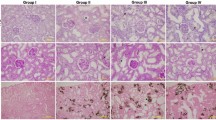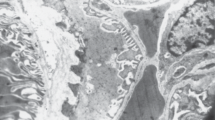Summary
Blocks of human normal renal pelvis and ureter obtained at the time of surgery were fixed in glutaraldehyde and osmium with or without ruthenium red, for electron microscopic observations. The transitional epithelium is arranged in three cell layers: basal, intermediate and superficial. All epithelial cells show numerous microvilli and contain the characteristic vesicles of transitional epithelium, bundles of cytoplasmic filaments, microtubules and numerous free ribosomes. The epithelial extracellular compartment is notably large and appears as an intricate, tridimensional network of canaliculi and cisternae which are wider in the intermediate and superficial layers and in which microvilli and cytoplasmic folds of vicinal cells are often attached or interdigitated. At these sites there are desmosomes.
The surface of all transitional epithelial cells is covered by a fibrillar mucous coat which is more developed at the plasmalemma of the free border of luminal cells in which microvilli are also seen. Ruthenium red stains selectively the plasmalemma and the mucous coat of the free surface of the epithelium, indicating the presence of an acid polysaccharide. With this technic (Luft, 1965), it is observed, radiating from the plasmalemma, branching filaments which measure 100 Å in diameter forming a zone of varying density which is about 400 mμ wide and which corresponds, at the light microscopic level, to the luminal border of the transitional epithelial cells in which a sialomucin has been identified. The slender filaments have a beaded appearance. At the free border, superficial cells are attached by functional complexes in which tight junctions seal the epithelial intercellular space, which is opened at the level of the basement membrane where only desmosomes are observed.
The ultrastructure of human transitional epithelium of urinary tract resembles the duct cells of the salt gland of certain marine birds (Fawcett, 1962) and the amphibian epidermis (Farquhar and Palade, 1965) in which there are active processes of transport. The mucous surface coat, selectively stained by the ruthenium red, contains a sialomucin (Monis and Dorfman, 1965, 1967).
The ultrastructure and histochemistry of the mucous fluffy coat of man transitional epithelium and the observations of Porter and Tamm (1955), on the ultrastructure of preparations of the Tamm and Horsfall mucoprotein (1952) are bases for suggesting that transitional epithelium of urinary tract of man is the site of biosynthesis of certain urinary mucoids. Present investigations are directed to obtain evidence to substantiate this hypothesis.
Similar content being viewed by others
Abbreviations
- B :
-
basal cell
- E :
-
exfoliating cell
- I :
-
intermediate cell
- L :
-
lumen
- S :
-
superficial cell
- SC :
-
surface coat
- bm :
-
basement membrane
- ci :
-
cell infolding
- d :
-
desmosome (macula adhaerens)
- f :
-
fibroblast
- fi :
-
cytoplasmic filaments
- is :
-
intercellular space
- jc :
-
junctional complex
- ly :
-
lysosome
- lym :
-
lymphocyte
- mt :
-
microtubules
- m :
-
mitochondria
- mv :
-
microvilli
- n :
-
nucleus
- r :
-
ribosomes
- rv :
-
round vesicle
- zo :
-
zonula occludens
- za :
-
zonula adherens
References
Battifora, H., R. Eisenstein, and J. H. McDonald: The human urinary bladder mucosa. An electron microscopy study. Invest. Urol. 1, 354–361 (1964).
Bennett, H. S.: Morphological aspects of extracellular polysaccharides. J. Histochem. Cytochem. 11, 14–23 (1963).
Brandt, P. W.: A Consideration of the extraneous coats of the plasma membrane. Circulation 26, 1075–1091 (1962).
Chambers, R.: The relation of the extraneous coat to the organization and permeability of cell membrane. Cold Spring Harbor Symposia. Quant. Biol. 8, 144 (1940).
Choi, J. K.: The fine structure of the urinary bladder of the toad Bufo marinus. J. Cell Biol. 16, 53–72 (1963).
Edwards, C. N., W. H. Boyce and C. S. Drummond, Jr.: Studies on Urothelium. II. Effect of parathyroid extract, vitamin D and dehydrotachysterol on some histochemical characteristics of canine transitional epithelium. J. Urol. (Baltimore) 86, 364–366 (1961).
—, and J. S. King, Jr.: Studies on Urothelium: I. Characteristics of canine transitional epithelium following isolation from the urinary stream. J. Urol. (Baltimore) 85, 802–809 (1961).
—, F. K. Garvey, and W. H. Boyce: Studies on Urothelium. III. Experimental vesical stone formation on the dog. J. Urol. (Baltimore) 89, 207–213 (1963).
Farquhar, M. G., and G. E. Palade: Junctional complexes in various epithelia. J. Cell Biol. 17, 375–412 (1963).
— and G. E. Palade: Cell junctions in amphibian skin. J. Cell Biol. 26, 263–291 (1965).
Fawcett, D. W.: Physiologically significant specializations of the cell surface. Circulation 26, 1105–1125 (1962).
—: Surface specializations of absorbing cells. J. Histochem. Cytochem. 13, 75–91 (1965).
—: An atlas of fine structure. Philadelphia: W. B. Saunders Co., 1966.
Gasic, G., and T. Gasic: Removal of sialic acid from the cell coat in tumor cells and vascular endothelium and its effect on metastasis. Proc. Nat. Acad. Sc. 48, 1172–1177 (1962).
Gottschalk, A.: Carbohydrate residue of a urine mucoprotein inhibiting influenza virus haemagglutination. Nature (Lond.) 170, 662–663 (1952).
—: The chemistry and biology of sialic acid and related substances. Cambridge: Cambridge Univ. Press, 1960.
Hay, E. D.: Epithelium. In: Histology, p. 74–98; edited by R. O. Greep. 2nd ed. New York: McCraw-Hill Book Co., 1966.
Hicks, R. M.: The fine structure of transitional epithelium of rat ureter. J. Cell Biol. 26, 25–48 (1965).
—: The permeability of rat transitional epithelium. Keratinization and the barrier to water. J. Cell Biol. 28, 21–31 (1966).
—: The function of the Golgi complex in transitional epithelium. Synthesis of the thick cell membrane. J. Cell Biol. 30, 623–644 (1966).
Hukill, P. B., and R. A. Vidone: Histochemistry of mucous and other polysaccharides in tumors. I. Carcinoma of the bladder. Lab. Invest. 14, 1624–1635 (1965).
Ito, S.: The enteric surface coat of cat intestinal microvilli. 27, 475–491 (1965).
-, and J. P. Revel: Incorporation of radioactive sulfate and glucose on the surface coat of enteric microvilli. (Abstract.) J. Cell Biol. 23, 44A (1964).
King, J. S., and W. H. Boyce: High molecular weight substances in human urine. Springfield (Ill.): Charles C. Thomas, Publisher, 1963.
Kurosumi, K., M. Yamagishi, and T. Yamamoto: The fine structure of the transitional epithelium of urinary bladder and its functional significance as disclosed by electron microscopy. Arch. Histol. Jap. 21, 155–183 (1961).
Leeson, C. R.: Histology, histochemistry and electron microscopy of the transitional epithelium of the rat urinary bladder in response to induced physiological changes. Acta anat. (Basel) 48, 297–315 (1962).
Luft, J. H.: Improvements in epoxy resin embedding methods. J. biophys. biochem. Cytol. 9, 409–414 (1961).
- The fine structure of hyaline matrix following ruthenium red fixative and staining. J. Cell Biol. 27, 61A (1965).
- Ruthenium red and violet. I. Chemistry, purification, methods of use and mechanism of action. (Preprint, 1966.)
Mende, T. J., and E. L. Chambers: Distribution of mucopolysaccharides and alkaline phosphatase in transitional epithelia. J. Histochem. Cytochem. 5, 99–104 (1957).
Monis, B., and H. D. Dorfman: Histochemical localization of sialic acid containing mucins in transitional epithelium of urinary tract of man in normal and pathological conditions. Amer. J. Path. 46, 38a (1965).
— and H. D. Dorfman: Some histochemical observations on transitional epithelium of man. J. Histochem. Cytochem. 15, 475–481 (1967).
- and D. Zambrano: Transitional epithelium of the urinary tract. Ultrastructural and cytochemical bases for an interpretation of its functional activity. Proc. of the 3rd. Internat. Meeting of Nephrology. Abstracts. Washington, D. C. Free Comunications, II, p. 245 (1966).
— y D. Zambrano: Ultraestructura del Epitelio de Transición en el Hombre. Sesiones Cientificas de Biologia 4, 113–114 (1967).
— and D. Zambrano: Transitional epithelium of urinary tract in normal and dehydrated rats. A histochemical and electron microscopic study. Z. Zellforsch. 85, 165–182 (1968).
Novikoff, A. B.: Lysosomes and related particles in the cell, vol. 2 (J. Brachet and A. E. Mirsky, eds.) New York: Academic Press 1961.
Odin, L.: Carbohydrate residue of a urine mucoprotein inhibiting influenza virus haemagglutination. Nature (Lond.) 170, 663–664 (1952).
Peachey, L. D., and H. Rasmussen: Structure of the toad urinary bladder as related to its physiology. J. biophys. biochem. Cytol. 10, 529–533 (1961).
Petry, G., u. H. Amon: Licht- und elektronenmikroskopische Studien über die Struktur und Dynamik des Übergangsepithels. Z. Zellforsch. 69, 169–167 (1966).
Porter, K. R., and M. A. Bonneville: An introduction to the fine structure of cells and tissues. Philadelphia: Lea & Febiger, 1963.
— and I. Tamm: Direct visualization of a mucoprotein component of urine. J. biol. Chem. 212, 135–140 (1955).
Reynolds, E. S.: The use of lead citrate at high pH as an electron-opaque stain for electron microscopy. J. Cell Biol. 17, 208–212 (1963).
Rhodin, J. A. G.: An atlas of ultrastructure. Philadelphia: W. B. Saunders Co., 1963.
Ritcher, W. R., and S. M. Moize: Electron microscopic observations on the collapsed and distended mammalian urinary bladder. J. Ultrastruct. Res. 9, 1–9 (1963).
Tamm, I., and F. L. Horsfall: A mucoprotein derived from human urine which reacts with influenza, mumps and Newcastle disease viruses. J. exp. Med. 95, 71–97 (1952).
Walker, B. E.: Electron microscopic observations on transitional epithelium of the mouse urinary bladder. J. Ultrastruct. Res. 3, 345–361 (1960).
Author information
Authors and Affiliations
Additional information
Dr. Monis wishes to thank Dr. E. De Robertis for the use of the electron microscope facilities of the Instituto de Anatomía General y Embriologia, Facultad de Medicina, Universidad de Buenos Aires. — Prof. E. Trabucco and Dr. R. J. Borzone (Cátedra de Clinica Genitourinaria de la Facultad de Medicina, Universidad de Buenos Aires) generously supplied the specimens which were the bases of this study. — Thanks are due to Mrs. A. M. Novara and Mrs. Defilippi-Novoa for efficient technical help and to Miss Rosa Gentile for secretarial assistance. Photomicrography by Mr. M. A. Saenz.
Dr. Zambrano is investigator (CNICT).
Rights and permissions
About this article
Cite this article
Monis, B., Zambrano, D. Ultrastructure of transitional epithelium of man. Z. Zellforsch. 87, 101–117 (1968). https://doi.org/10.1007/BF00326563
Received:
Issue Date:
DOI: https://doi.org/10.1007/BF00326563




